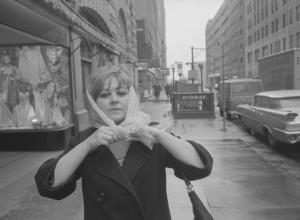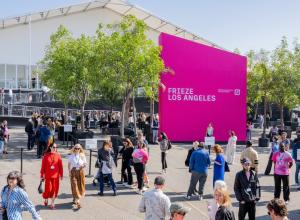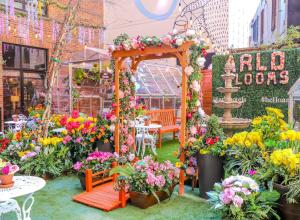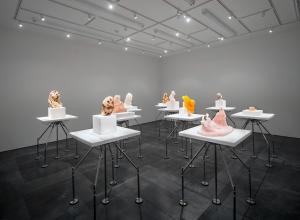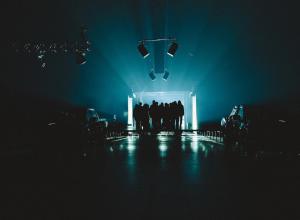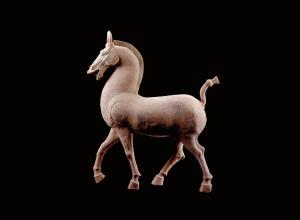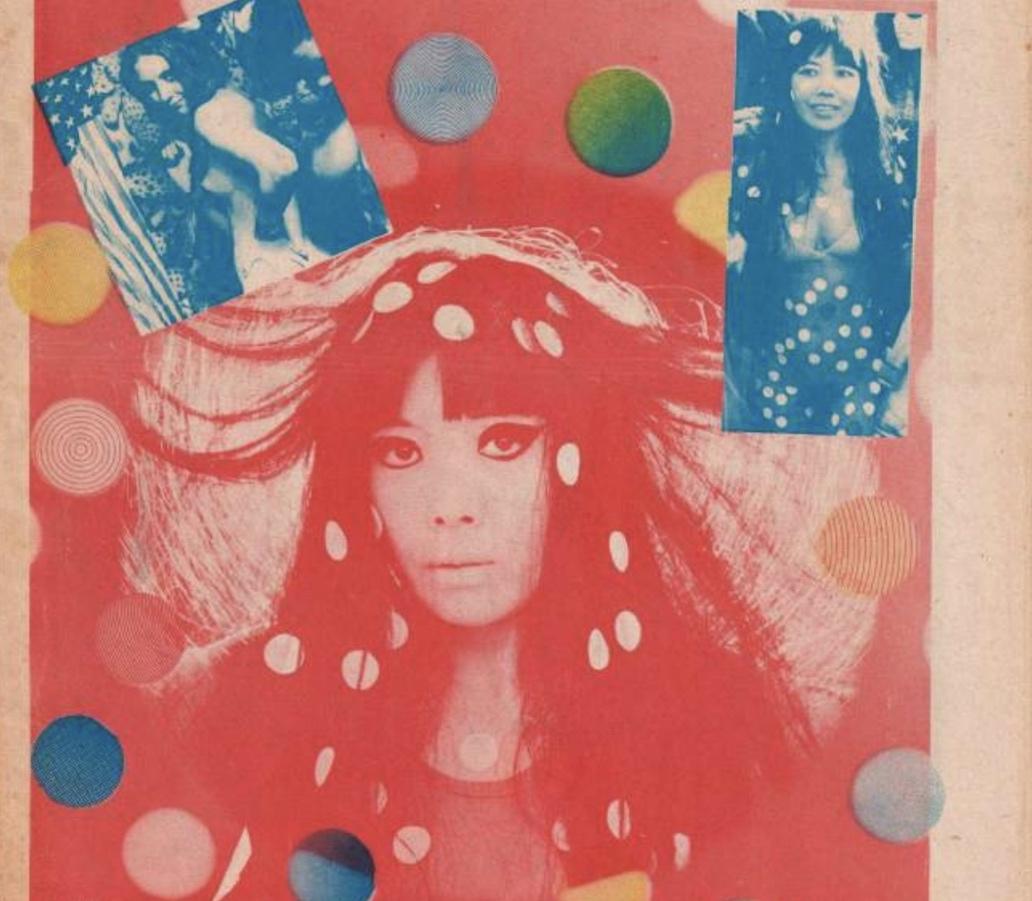
Yayoi Kusama, detail of Kusama Presents An Orgy : Nudity, Love, Sex & Beauty For Adults Over 21, 1969. Offset-printed. 17.3 x 11.4 in.
What’s not to like about the Independent Fair? The seasonal location at the iconic Maritime Building—built in the beaux-arts architectural style—is one of the most beautiful places in New York. It’s ornate and allows you spectacular views of the waterfront, and when the weather permits, it’s a great perch for people-watching.
This year’s inaugural Independent 20th Century edition has something for everyone. Presented by thirty-two galleries selected by founding curatorial advisor Matthew Higgs, the event includes over seventy artists, twenty-two solo and duo artist presentations, and special projects commissioned especially for this fair. If you can’t make it to New York, feel free to visit the online platform, which will remain open through September 30, 2022.
But here, we will look at eleven booths, where the work and the ideas are as individual as we all are.
My tour will take you through a couple of floors and across geographic and historic periods in modern and contemporary art. This is the delight of the Independent Fair. Lean into the complexity of the various artists and the wide range of approaches and styles and enjoy.
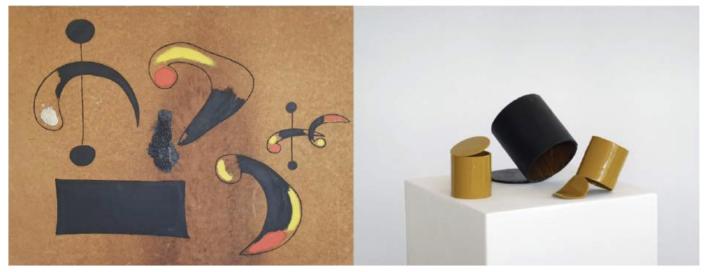
(L) Joan Miró, Peinture, 1936. Oil, casein, tar and sand on Masonite. (R) Peter Fischli, Untitled, 2022. Cardboard, newspaper, construction paper, wallpaper, glue, champagne chalk, layers of emulsion, acrylic, silicate, faux rust, gouache, and enamel paint.
Luxembourg + Co. has one of the more interesting pairings with paintings by the Catalonian artist Joan Miró (1893-1983) with contemporary sculptor Peter Fischli (1952-). Miró's works shown here on easels were done amidst the Spanish Civil War. The artist used masonite combined with sand and tar to produce a more sculptured space in the painting. Fischli’s cardboard assemblages of opened paint or food cans, randomly placed, call into question the hierarchy of the art object and the suitability of the means of making it.
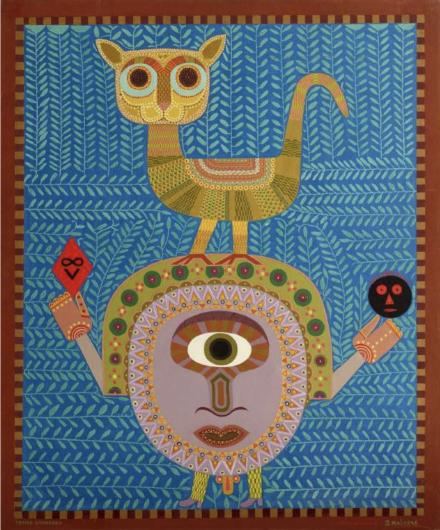
Victor Brauner, Temps sombrero, 1948. Oil on canvas. 28.74 x 23.62 in.
A newcomer to the Independent Fair (and one of my favorite exhibitors) is Galerie 1900-2000. This gallery will exhibit works on paper, paintings, and photographs by artists associated with Dada and Surrealism up until the 1960s. Here, their installation highlights the work of Victor Brauner, a Romanian sculptor and painter, who took refuge from World War II in the Pyranees. He returned to France in 1938, and in late August of that year, he lost his left eye in a fight. Interestingly, this happened a few years after he painted Self Portrait with Enucleated Eye. On the surface, the work is a cross between Paul Klee and Max Ernst. Brauner is credited with developing a pictographic encaustic technique in which he incised imaginative figures into the surface and then filed with them with pen and ink.
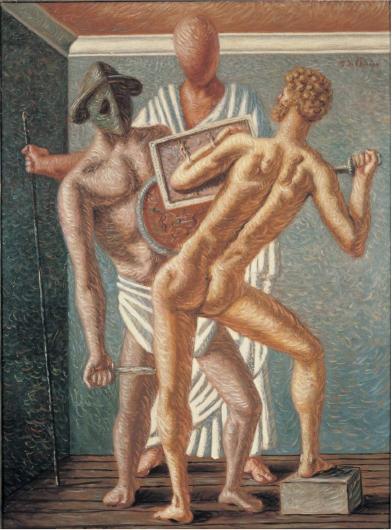
Giorgio de Chirico, Gladiatori (Gladiators), 1928. Oil on canvas. 51.18 x 38.19 in.
If you missed a trip to Italy this summer, you get to not only take a quick trip to Italy, but also one back in time to the 1920s with Giorgio de Chirico.
Nahmad Contemporary presents some very uncharacteristic work De Chirico—traditionally-inspired paintings of warring gladiators. Turning away from modernism in 1919, De Chirico sought to embrace traditional painting themes and techniques and created these large classical works for the home of Parisian art dealer Léonce Rosenberg.
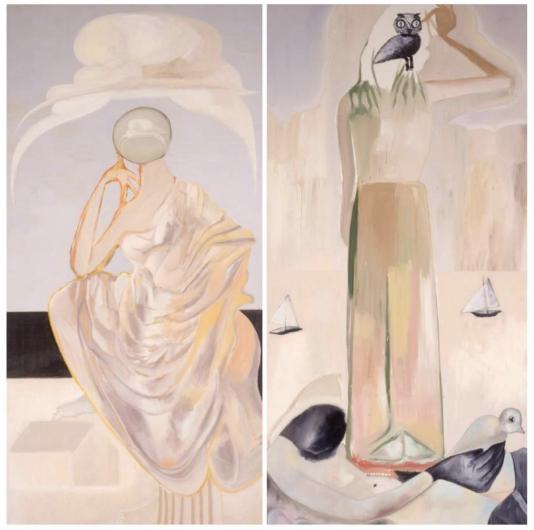
(L) Francesco Clemente, Dormiveglia V, 1998. Oil on canvas. 130 x 45 1/4 in. (R) Francesco Clemente, Dormiveglia VI, 1998. Oil on canvas. 130 x 45 1/4 in.
Following in this neoclassical vein, Vito Schnabel presents a series of nine monumental paintings by Francesco Clemente from 1998 entitled Dormiveglia. Also in a much larger scale than we expect from Clemente, the title alludes to the state between sleep, a waking dream, and reality. The cryptic symbol or fragmented goddesses on the horizon allude to the artist’s engagement with the arcane, the tarot, and the occult. These contemplative works arise out of the mystical tradition of sublime space and poetry at the end of history. The horizon line of the picture space is where the dark sea meets the sky—a landscape behind a landscape. Birds and ships float amidst this mythology and philosophy of the sacred and the arcane.
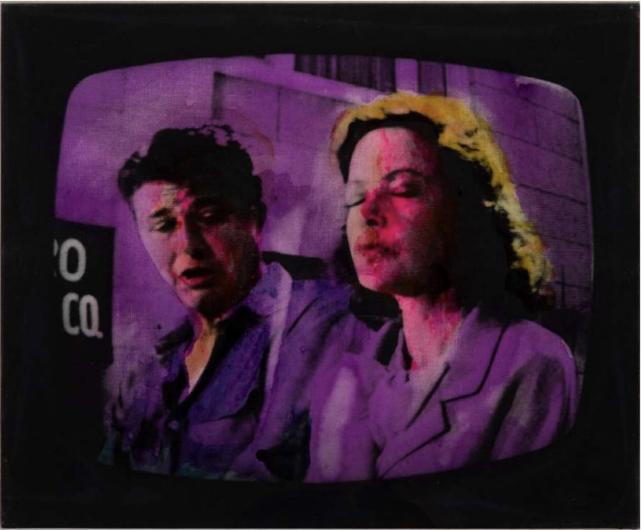
Mario Schifano, Paesaggio TV, 1970, Enamel. Aniline and emulsion on canvas with perspex. 42.5 x 51 x 2.5 cm.
Studio Marconi of Milan presents Mario Schifano’s Personaggi TV, a series of freeze frame, television stills retouched in densely saturated colors that first exhibited in the 1970s. Schifano owed his experimentation in new media and film especially to his exposure to the underground films realized in New York. The artist saw all of them and retained a vivid impression that would leave an imprint on all the films he realized in 1964.
Schifano was associated with New Realism and he involved himself with multimedia experiments reminiscent of Andy Warhol. Schifano’s use of film and television was extremely influential on a younger generation of artists who revived painting and figuration in the 1980s. Schifano can be seen as the relevant bridge figure between postwar and contemporary art—anticipating many practices which are still relevant today.

Stanislao Lepri, L’offerta, 1971. Oil on canvas. 28 3/4 x 39 3/8 in.
Galleria Tommaso Calabro presents the work of the visionary Italian painter Stanislao Lepri (1905-1980). A former diplomat, Lepri's life reads like a movie script. He was the romantic partner of Italian-Argentinian Surrealist Leonor Fini, an unconventional bohemian who welcomed Polish writer Constantin Jelenski into his home for a ménage à trois.
Much like Fini, Lepri’s works are a compilation of childhood memories and the locations in which he grew up, all filtered through the collective consciousness of fascism and war—much like our present moment.
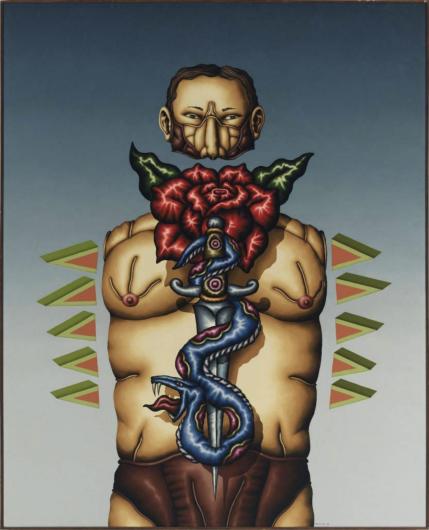
Robert Lostutter, Untitled, 1972. Oil on canvas with painted frame. 60 x 49 in.
Corbett vs. Dempsey titled their booth “Before and After Imagism,” championing the Chicago school: Roger Brown, Ed Flood, Art Green, the mystical Philip Hanson, Christina Ramberg, and Richard Wetzel. These figurative iconoclasts coalesced around SAIC and showed together at the Hyde Park Art Center in the late 60s. Their wild blend of Surrealism, Pop, folk art, cartoons, and humor posed a heady alternative to the dominant abstraction of New York and Los Angeles.
Exploring points of continuity and divergence between the Imagists, the gallery’s selection includes works by Robert Lostutter, Miyoko Ito, and Gertrude Abercrombie, and later figures such as Diane Simpson, Brian Calvin, and Rebecca Shore. Look out for the paintings and drawings of Robert Lostutter. Lostutter’s hybrid figures struggle with their psychoses and explore the meaning of man’s animal nature. Beautiful and frightening, these otherworldly characters leverage man as a machine or man as an animal in a refined and precise style.
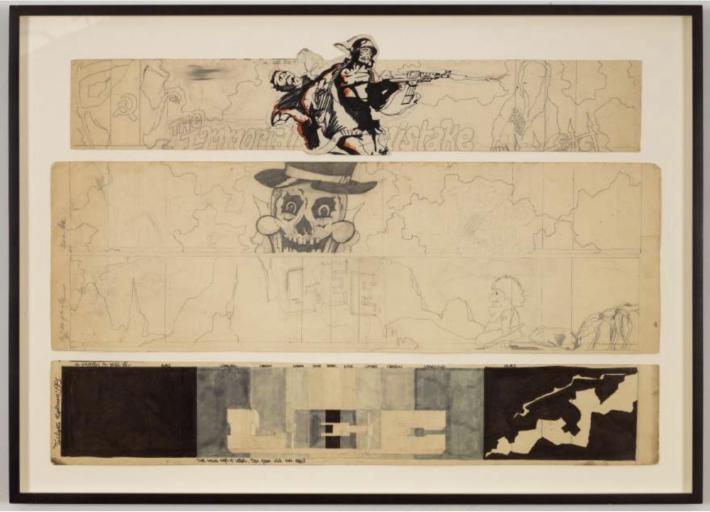
Lee Quiñones, Whole car cluster #2, 1980–1983. Alcohol marker, ink, and pencil on poster board card stock. 20 x 28 1/2 in.
This subway graffiti artist Lee Quiñones has been on the comeback trail for the past couple of years. Ross+Kramer are exhibiting a series of very tight drawings which combine Quiñones’ 1980s shadow figures and superheroes. With the right distance, Quiñones’ assemblage of issues—from the train taggings to music themes—give the paint strips a wonderful cinematic effect and energy.
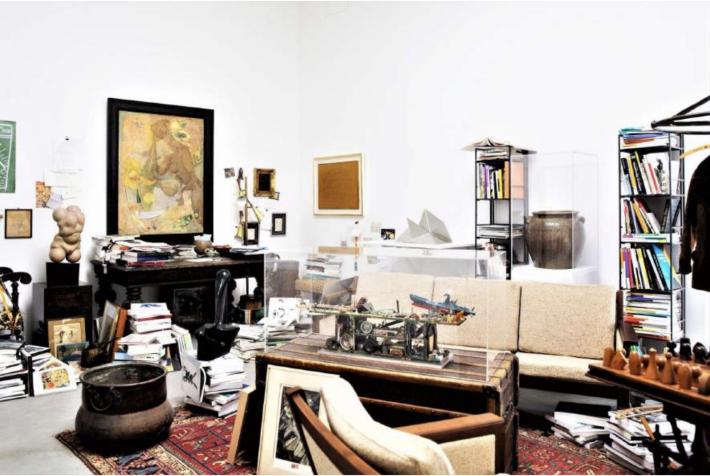
Hong Gyu Shin’s Apartment.
Shin Gallery is exhibiting works by a number of artists whom they have collected and shown in a recreation of the gallery owner and collector Hong Gyu Shin’s apartment. The installation reflects a different approach to collecting as a passionate enterprise with appreciation not only of the artwork but also of the memorabilia and ephemera to pass a piece of history onto the viewer.
This installation will juxtapose the ceramics of David Drake, the first known enslaved African American potter to sign his work when doing so was in direct defiance of anti-literacy laws. Drake carved words and poems into vessels and jugs and these texts are being treated as importantly as those of Balthus, a modernist who challenged our notions of acceptability.
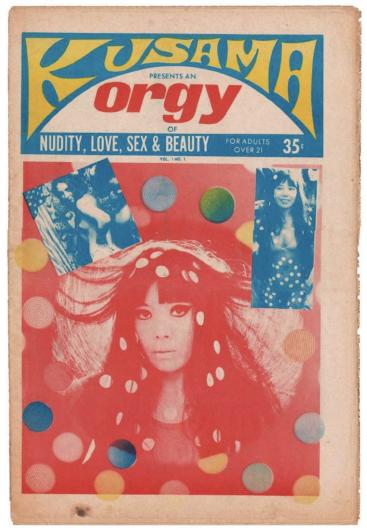
Yayoi Kusama, Kusama Presents An Orgy : Nudity, Love, Sex & Beauty For Adults Over 21, 1969. Offset-printed. 17.3 x 11.4 in.
Susan Inglett has teamed up with her husband David Platzker’s holdings from his enterprise, Specific Object to exhibit artists' publications, editions, and print ephemera from the period of 1969. This “Summer of Love” revolutionary moment includes material related to anti-war, pro-choice movements, the Art Worker’s Coalition, and Yayoi Kusama’s Orgy tabloid.
![Wallace Berman, Untitled [O ASS], 1966. Newsprint. 19 x 14 in. (image), 27 x 22.5 in. (framed). Courtesy of Nicole Klagsbrun and Independent New York.](https://cdn.artandobject.com/sites/default/files/styles/slideshow_image/public/wallace-berman-untitled-o-ass-1966-newsprint-19-x-14-image-27-x-225-framed-courtesy-nicole-klagsbrun.jpg?itok=Rq0tU958)
Wallace Berman, Untitled [O ASS], 1966. Newsprint. 19 x 14 in. (image), 27 x 22.5 in. (framed).
Hervé Bize and Nicole Klagsbrun are exhibiting together in hopes of fostering a clearer picture of artistic experimentation since the 1980s. Because of the constraints of time, there is no efficient way to discuss the period. Bize has assembled European conceptualists such as François Morellet and André Cader. Klagsbrun is including American Beat poet John Giorno and multimedia California practitioners Wallace Berman and Jay DeFeo. The selection of works emphasizes the strong relationship to language across generations and countries. Be on the lookout for sculpture by the legendary George Hermes.

(L) Joan Miró, Peinture, 1936. Oil, casein, tar and sand on Masonite. (R) Peter Fischli, Untitled, 2022. Cardboard, newspaper, construction paper, wallpaper, glue, champagne chalk, layers of emulsion, acrylic, silicate, faux rust, gouache, and enamel paint.
Luxembourg + Co. has one of the more interesting pairings with paintings by the Catalonian artist Joan Miró (1893-1983) with contemporary sculptor Peter Fischli (1952-). Miró's works shown here on easels were done amidst the Spanish Civil War. The artist used masonite combined with sand and tar to produce a more sculptured space in the painting. Fischli’s cardboard assemblages of opened paint or food cans, randomly placed, call into question the hierarchy of the art object and the suitability of the means of making it.

Victor Brauner, Temps sombrero, 1948. Oil on canvas. 28.74 x 23.62 in.
A newcomer to the Independent Fair (and one of my favorite exhibitors) is Galerie 1900-2000. This gallery will exhibit works on paper, paintings, and photographs by artists associated with Dada and Surrealism up until the 1960s. Here, their installation highlights the work of Victor Brauner, a Romanian sculptor and painter, who took refuge from World War II in the Pyranees. He returned to France in 1938, and in late August of that year, he lost his left eye in a fight. Interestingly, this happened a few years after he painted Self Portrait with Enucleated Eye. On the surface, the work is a cross between Paul Klee and Max Ernst. Brauner is credited with developing a pictographic encaustic technique in which he incised imaginative figures into the surface and then filed with them with pen and ink.
Kathleen Cullen
Kathleen Cullen is a former gallerist, independent curator, and writer for CultureCatch.com. She was also the former head of sales for Art & Object. Cullen’s role as a director-curator permits her to maintain an independent spirit, presenting new artists “on the edge” by feeling the “pulse” of the emerging art market. It is this inalienable eye that posits her as a harbinger of new artistic expression.





